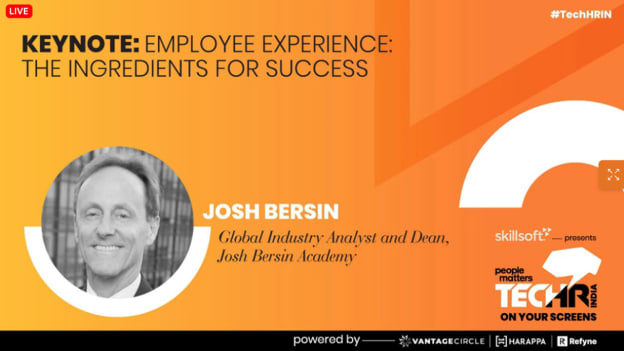EX is about creating a sense of belonging: Josh Bersin

The idea that employees need to be happy at work is hardly a new one. It's been around for 13 years, estimates global industry analyst Josh Bersin, and it's closely entwined with digital transformation.
But now, with the pandemic sinking economies around the world and driving businesses to the hybrid or fully remote model, employee experience has gotten complicated. Speaking on the second day of People Matters TechHR India Conference 2021, Josh said: “There's a lot of issues involved...in this particular economic cycle, almost everything is happening at the same time.”
Between labour shortages and the need to be more diverse and inclusive in hiring, he says that employee experience and retention is now a financial urgency in companies, and that both are being heavily impacted by the difficult pandemic environment—so that HR and business leaders are now trying to do everything they can to make work a better place for people. But what are the really key factors that enable this effort?
Create a sense of belonging
Pointing to research that the Josh Bersin Academy carried out in partnership with Microsoft earlier this year, Josh explains that the number one driver of engagement right now is a sense of belonging. “When you're working in a high stress situation at home or in your social life or your family life, you want work to be a place where you feel comfortable, a place where you feel safe,” he explained.
This sense of belonging is closely followed by other aspirational aspects, such as trust in the organisation, transparency, inclusion and care, and a sense of mission and purpose beyond financial goals.
The second big driver of engagement is the need for growth, mobility, development, and recognition. As Josh puts it, “When people feel that their work is being appreciated, they're rewarded, and they're growing and developing themselves in their jobs, they will go home at night and say 'It was a good day today. I enjoyed my work today.'”
And a third big driver is cultural factors such as having a culture of learning, a sense of psychological safety, well-being, and flexibility. Employee well-being and psychological safety are particularly important, because as Josh points out, well-being is frequently approached as a tool, taking the form of benefits or rewards to be offered to employees. But it is more than that: it is part of creating a sustainable environment at the management level.
Focus especially on the cultural aspects
“A good half to almost two-thirds of companies look at EX as a transactional efficiency problem—how do we make it easier for people to find things in the employee portal, how do we simplify the number of tools we have in the company,” Josh observes—and, he says, these companies do get financial results simply because employees find it easier to do their jobs and are less likely to leave out of frustration.
“But when you focus on mission and purpose, your retention and your engagement goes up by a very significant amount. And when you focus on equity and diversity and inclusion and psychological safety, you liberate people to do even more to create, to innovate, to take even better care of customers.”
That's not to say that companies should deprioritise technology. With the widespread advent of the hybrid working model, business has broken into a new paradigm of work, Josh says—one where technological tools are now mainstream and it is not just common, but expected that employees will ask for more flexibility in their work experience.
“As you address the EX problems in your company, one of the most important things is simplification of technology,” he advises. Companies, he believes, need to use the tools of HR within the flow of work, and they need to streamline it. If there are too many different tools and too many different systems, it defeats the purpose of making employees' lives easier.
EX is not just HR's problem alone
Finally, it's important to recognise that EX is the combination of multiple factors about the workplace, which are managed or controlled by many different teams.
“HR and HR technology is now in the mode of designing employee experiences, developing journeys, and giving managers and employees tools so that they can make their employee experience better,” Josh says. But, he points out, many of the things that affect EX are not properly in HR's purview—they are often managed by other people, from the IT function to the leadership and even the facilities management team.
And so, he believes, the EX domain will require a cross-functional team as it evolves, and HR leaders should be either among the leadership of that team, or its sponsors.
“The EX problem is not an HR problem,” he says. “It's a cross-disciplinary initiative in the company as a whole, to build a productive, engaging, meaningful experience for people.”
















